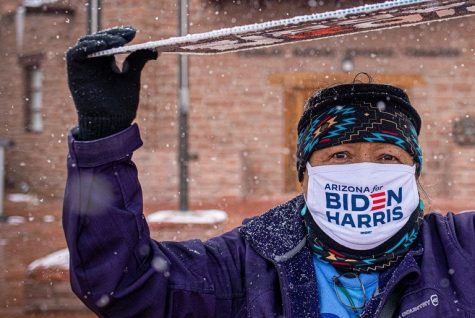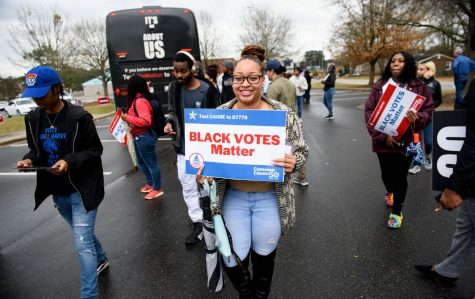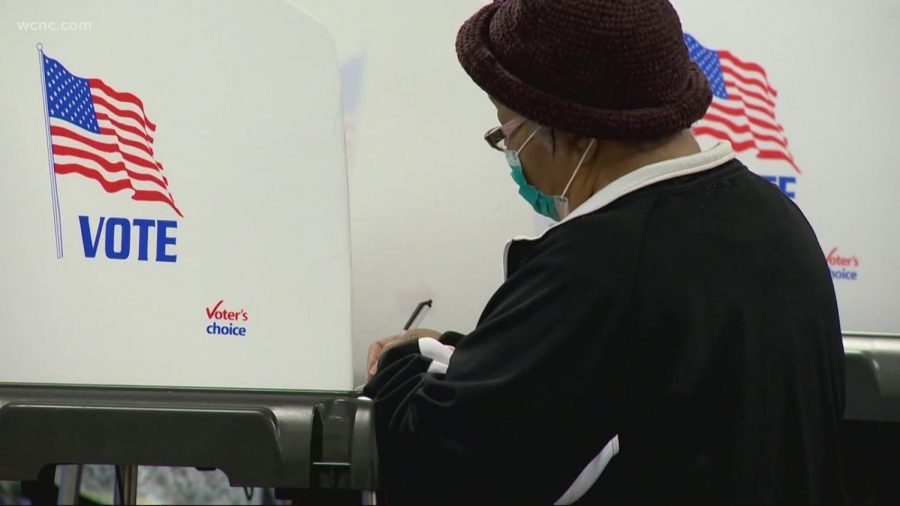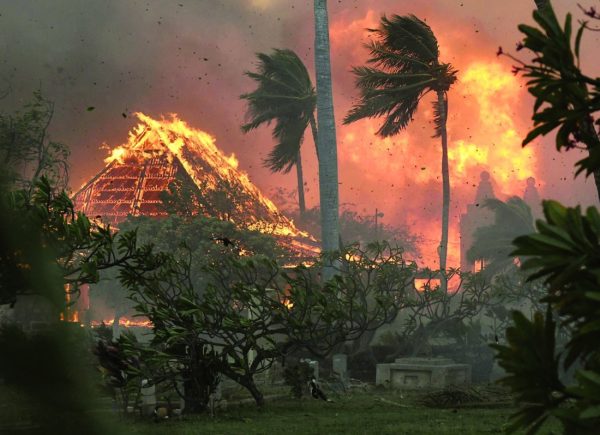Minority Population and Voter Turnout
Voter casting their vote in the historical 2020 election.
March 15, 2021
The 2020 Presidential election was arguably one of the most important elections in our lifetimes. November 3, 2020, marked the day that Americans were tasked with choosing between two competing visions for the future of the United States. The American people, minorities in particular, played a key role in the outcome of this historical presidential election.
On election day, Native American and Indigenous people raced to the polls as they were eager to cast their vote in a race to save our democracy. Native voter turnout dramatically increased overall seeing an increase ranging from 40-60% in Native voter turnout. This number is extremely impressive considering the voting blockades that Native voters face. In each county, the election administrators have to know where a voter lives in order to give them accurate boundaries which ultimately decide which ballot a voter will receive, where they vote, and which positions they vote for. In rural states such as Utah, residents could register to vote by describing an approximate location of their home which was made possible by the National Voter Registration Act of 1993. While there are states that abide by the National Voter Registration Act of 1993, there are many others that have extremely strict voter identification laws. These strict laws require an exact and proper address in order to register to vote. On Native reservations, traditional addresses are not common and many homes are not assigned a traditional address. This has made it increasingly difficult for Natives living on rural reservations to cast their votes. For example, the Navajo Nation has approximately 50,000 unaddressed homes and businesses which bars hundreds of thousands of Native people from casting their votes in the ballot box. Along with this detrimental voting blockade, there are many others such as the lack of polling sites on rural reservations, the lack of voter material in Indigenous languages, and the inability to use tribal IDs for voter registration in many states.

While these blockades have discouraged Native voters in the past, the 2020 election proved to be quite different. In battleground states such as Wisconsin, North Carolina, and Arizona, Native voters were a crucial element in the outcome of the election. Navajo Nation for example is the largest Native American reservation in the entire country. In Arizona in particular, Biden won by only 10,500 votes and it is hard not to make the argument that Native votes did not play a crucial role in the outcome of the electoral votes. Arizona was decided by very few votes which legitimize the claim of the citizens of the Navajo Nation that their ballots truly made the difference. In Arizona, Native American people make up approximately 6% of the eligible voters, but 97% of the Navajo votes went to Biden giving him almost 74,000 votes which made it possible for Arizona to turn blue. Counties near Navajo Nation such as Apache County and Hopi tribe saw a 116 percent increase in voter turnout compared to the 2016 election. Wisconsin is another example of the power of the Native vote. Wisconsin is a swing state and is home to approximately 90,000 Native Americans and Joe Biden won by about 20,000 votes. He won roughly 1,300 votes which gave him 82 percent of the total vote in Menominee County which is home of the Menominee Nation. Bayfield County is in northern Wisconsin and is home to the Red Cliff Ojibwe tribe. This area has roughly an 11 percent Native population, but Biden won there as well by just over 6,000 votes. While Biden won in these areas by very few votes, his victory in Indian country and in counties that bordered Native Reservations was made possible by Native American voters.
Other minority groups have played significant roles as well in key battleground states. There was record voter turnout among African American voters and this was a huge contributing factor to Biden’s victory. The biggest example of the influence of Black American voters was in the state of Georgia where Biden was the first to win the Republican stronghold state in almost thirty years. Exit poll data from the election showed the power of the black vote considering that “Black Americans made up over 50 percent of all Democratic voters in the state of Georgia, 20 percent of Democratic voters in Michigan, and 21 percent of all Democratic voters in Pennsylvania” (Rashawn Ray). In many of the key swing states, Black Americans tend to live in metropolitan areas. For example, 70% of Black Americans in Michigan live in Detroit, 60% live in Atlanta in Georgia, and 65% live in Philadelphia in Pennsylvania. While those living in cities made a huge contribution, those in the suburbs had an equally large impact. Suburbs such as Cobb County saw an increase in the Black population from 25 percent to 28 percent and the white population has decreased from 62 percent to 56 percent and this pattern is true of many other counties such as Gwinnett County, Clayton County, and Forsyth County. This increase in the Black American population and decrease in the white population in these counties made it possible for Biden to win traditionally Republican-leaning suburban areas.

Additionally, Black American voters backed Joe Biden by a margin of 87 percent and Donald Trump had just 12 percent. Across the country, there has been a dramatic increase in the turnout of voters among young people. Young people turned out in record numbers, and with four in ten eligible Black American voters being Millenials or from generation Z, the push to increase voter turnout in metropolitan areas such as Philadelphia and Detroit was crucial for Biden’s victory. It is thought that turnout could have been boosted by new rules that made it easier to vote during the COVID-19 pandemic. Many Black Americans experienced long lines during the primary elections in states such as Wisconsin and Georgia, so many were motivated to take advantage of the mail-in and early voting opportunities leading to an increased number of Black American voter turnout. Organizations such as the NAACP were another driving force in the election as they spent millions of dollars to encourage voters to go and cast their vote, especially in key swing states. Their efforts, and the efforts of many other organizations, were a driving force in the voter turnout in the election.
As voters from every part of the country hurried to the polls or mailed in their ballots, they positively changed the course of the 2020 election. Voter turnout in minority communities across the country greatly contributed to President Joe Biden’s victory, ensuring the security of our nation’s democracy.













